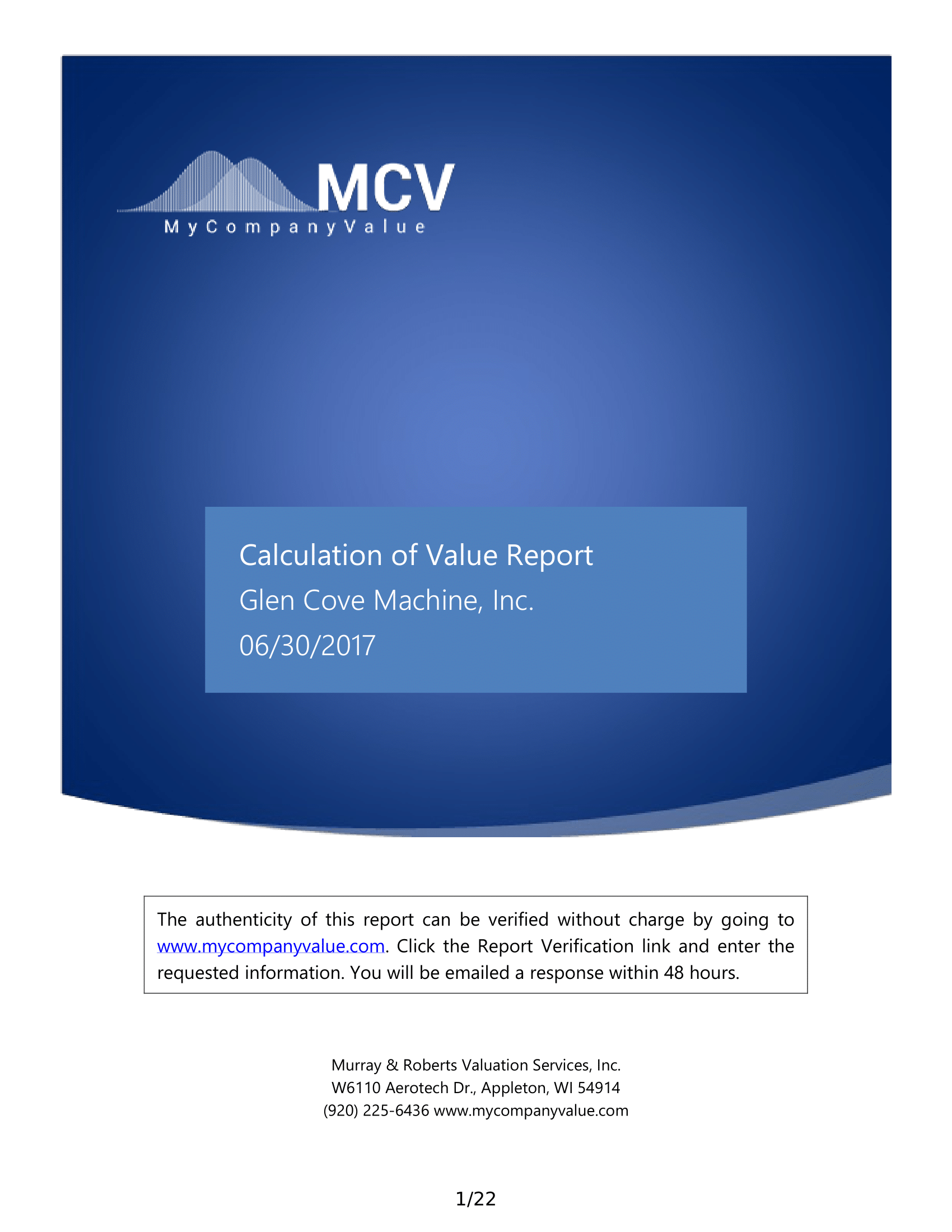How to Spot a Bad Business Valuation

September 15, 2016
Credentialing bodies such as the AICPA, the ASA, and the NACVA have done much in recent years to improve and standardize appropriate valuation practices, yet there are many report writers still using outdated or questionable methodology.
A quality business valuation report carefully documents the methodology applied, considers all relevant factors, uses all possible valuation approaches, and minimizes the use of estimated or arbitrary factors. The following are some of the most common errors and abuses found in valuation reports:
1. Undocumented Conclusions.
One very popular online business valuation service produces a report that has completely undocumented conclusions. The report is full of comparisons of the company’s financial statement data to industry averages, but it does not document the actual calculation steps applied to arrive at your business’s value. A solid business valuation is thoroughly documented with nothing left to mystery.
2. Use of Arbitrary Factors.
Buried in many reports I will frequently find the application of an “earnings multiple” or other undocumented estimate, which often becomes the basis of the final opinion of value. Pinning the conclusion of value on the application of an undocumented factor will typically cause the report to be disregarded in a courtroom. Ultimately, the conclusion of value is unsupported and therefore unreliable. (For more about this topic, see my article titled How to Use Earnings Multiples.)
3. Lack of a Market Approach
One of the practices that I consider less reliable or even out of date is the Guideline Company Method. It’s the ‘old-school’ method applied under the Market Approach. In that method an expert finds the single most comparable publicly traded company available and uses its value as the basis for determining the value of your company.
For small companies, using a guideline company is impossible because there are no companies that are publicly traded in its size range. Unfortunately, many valuation experts see the guideline company method as the only method available under the market approach, and therefore will not use any comparable sale information in their small company valuations.
There are several very good databases of private company transactions available to give an expert a reliable indication of value in most cases. Further, using a database allows the expert to use a subset of companies to base their value determination on, not just one company. Basing your company’s valuation on only one company significantly increases the possibility of producing a skewed result because all of the factors affecting the value of a single company cannot be known to the expert. (For more information about the proper application of the Market Approach to small company valuation, see my article titled The Best Comparable Transaction Analysis.)
4. Use of the Excess Earnings Method
The use of the Excess Earnings Method in business valuation is another ‘old-school’ method which is slowly becoming extinct, principally because of its highly theoretical and poorly documented nature.
When determining the value of your company, an expert will apply multiple approaches using independently determined variables. This is not unlike the appraisal of a house, where the appraiser considers a property’s rental value, the cost to construct new, and what similar properties have recently sold for. Using different approaches with independent variables gives the final conclusion of value much more credibility.
More often than not, use of the Excess Earnings Method is little more than window dressing. First, the method itself is purely theoretical. It attempts to measure the return on investment required on the equipment invested in the enterprise, as though that were somehow different than the return on investment required for the enterprise itself. In the real world, companies buying equipment use their own investment criteria, which is ultimately derived from their long term capital structure and required rate of return to equity. There is no universal equipment rate of return based on market derived data. The expert inevitably includes some arbitrary data to determine the appropriate rate of return on equipment.
Second, some of the factors used in the approach (such as normalized cash flows, the discount rate applied to the excess earnings, and the fair market value of equipment) are the same factors used in other approaches. Use of the approach gives the illusion of an independently determined value, when it is not.
5. Deducting Corporate Income Taxes from Subchapter S Corporation Earnings
Holdouts to this practice argue that if the tax isn’t paid at the corporate level, then it’s paid at the shareholder level. This is false. Some corporations’ earnings are subject to double taxation and others (S corps) are not. Dividends received from corporations that pay the corporate income tax (C corps) are subject to a lower tax rate at the shareholder level, but this should be taken into account when valuing the earnings of the C corp, not the S corp.
Private equity investors rarely (if ever) adjust S corporation earnings for corporate taxes when they do not anticipate changing the corporation’s tax election. More frequently they will remove corporate taxes paid on a C corporation when they intend to convert to an S corporation after purchase. (For more on this subject, see my article titled Are We Tax Affecting the Wrong Earnings?)
6. No Adjustment for Capital Structure
Many companies do not optimize their capital structure (appropriate use of debt) to maximize shareholder return on investment. This is common with many successful family owned businesses who have become debt free. Frequently valuation experts will value the company based on its existing capital structure. An informed buyer will consider the availability of debt and the effect it has on the return on equity. If informed buyers are factoring this into their valuations, then it must be incorporated into our valuation math. (For more about this topic, see my article titled The Importance of Adjusting for Capital Structure.)
7. No Adjustment for Working Capital
The company value arrived at under the income approach includes all capital required – including working capital (working capital is total current assets less total current liabilities). An expert must make some effort to determine the amount of working capital a rational investor would expect the company to need, and compare that amount to the working capital on hand as of the valuation day. This can be found by applying size appropriate industry average data to the subject company.
Large working capital adjustments are not uncommon. In every business acquisition I have worked on, there has been language in the purchase contract discussing the extent to which working capital items were included in the purchase price.
8. Application of a Control Premium
Mergerstat publishes data summarizing premiums paid in public company acquisitions, and labels these premiums as ‘control premiums.’ These premiums supposedly represent the premium a buyer is willing to pay to acquire a controlling interest in the target company.
According to valuation industry expert Shannon Pratt, these premiums actually represent the synergistic opportunity the buyer expects to derive by combining the assets of the acquired company with their existing assets. According to Pratt, the financial benefit of control in most public companies is very small. Therefore, the equity returns used in developing the discount rate do not need to be adjusted for the benefit of control.
The benefit of control should be determined by adjusting the normalized cash flows for the owner’s control items (excessive salaries, rents, benefits, etc.) If the valuation is based on controlling cash flows, applying a control premium to the stock or discount rate is a clear error.
Hiring an expert who has been certified by the AICPA, ASA, or NACVA should minimize the chance you’ll see these kind of errors, but will not eliminate it. Experts need to continually educate themselves on the best practices used, read competitors reports, and have merger and acquisition consulting experience. Nothing can replace the experience gained from participating in direct negotiations with buyers and sellers. Frequently these negotiations will include discussions over the value implications of many individual adjustments.
Brian Murray CPA/ABV, CVA specializes in business valuation, merger and acquisition consulting, and has served as an expert witness in court.

BRIAN MURRAY CPA/ABV CVA
Company founder Brian Murray CPA/ABV, CVA (Accredited in Business Valuation, Certified Valuation Analyst) has been in public accounting since 1997. Prior to that he was in finance at Kimberly-Clark Corp., audit at M&I Bank Corp., and accounting manager at Browning-Ferris Ind. Brian's areas of specialty are estate and trust tax and business valuation.Brian's community involvement includes: serving as Treasurer of the Salvation Army Fox Cities, serving on the Board of Directors of the Fox Valley Humane Society, serving on the Board of Directors of Big Brothers/Big Sisters, serving on the Board of Directors of the Wildwood Film Festival, and serving on the Board of Directors of Mothers and Unborn Baby Care. Brian also volunteered as a Big Brother for four years, and for United Way's fundraising campaign for multiple years. Brian and his family live in Neenah, WI.
Brian has been consulting clients regarding business value and merger & acquisition transactions since 2000. The majority of the valuation reports written were to aid a buyer or seller in a transaction or negotiation. Brian has often served as lead negotiator for prospective buyers or sellers.
Brian has served as an expert witness in corporate litigation cases as well as divorce, and has performed valuations for estate and gift tax returns, and estate planning.
